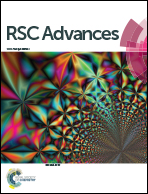Luminescent properties of Eu-doped magnetic Na3FeF6†
Abstract
Sodium iron fluoride (Na3FeF6) is a colorless ferromagnetic fluoride with a monoclinic crystal structure (space group P21/c), and it is expected to be an ideal platform for exploring magneto-optical interactions. In the present work, Eu3+ doped Na3FeF6 micro-powders were synthesized by a hydrothermal method, and the structures were examined by X-ray diffraction (XRD) and scanning electron microscopy (SEM). The optical properties were examined using UV-Vis spectra and fluorescence spectra, and the results show that the emission spectra can be finely tuned by the hydrothermal reaction temperature and doping concentration of Eu ions. We found that Na3FeF6 doped with 5% Eu3+ synthesized at 196 °C exhibited the optimal red emission under excitation at 395 nm. The magnetization of Na3FeF6:5% Eu3+ decreased rapidly from about 7.85 emu g−1 at 5 K to 0.4 emu g−1 at 60 K, then slowly decreased with temperature increase from 60 K to 300 K. This Eu3+ doped Na3FeF6 powder is expected to find potential applications in the field of magneto-optical modulation and relevant devices.



 Please wait while we load your content...
Please wait while we load your content...